FY2013 Annual Report
Quantum Dynamics Unit
Associate Professor Denis Konstantinov
August 2014: (left to right) Ryo Yamashiro, Sasha Smorodin, Olexiy Rybalko (OIST Visiting Researcher, Summer 2014), William Powell, Alex Badrutdinov, Prof. Denis Konstantinov, Slava Dvornichenko, Leonid Abdurakhimov, Rustin Nourshargh (Intern Student, Summer 2014)
Abstract
In FY2013, we continued our studies of microwave-induced phenomena in a 2D electron system on the surface of liquid helium. Several interesting results were observed and reported, in particular, in the Physical Review Letters, and more reports are under preparation. Also, we started developing new experimental tools, such as a cryogenic millimeter-wave spectrometer for ESR, a device for single-electron detection, etc., which hopefully will open new directions in our research of electrons on helium in the following years. In addition, we successfully started low-temperature NMR experiments with solid antiferromagnets and secured a three-year research grant from MEXT for these studies.
1. FY2013 Staff
- Alex Badrutdinov, Researcher
- Leonid Abdurakhimov, Researcher
- Ryo Yamashiro, Researcher (from January 2014)
- William Powell, OIST PhD Student
- Jui-Yin Lin, OIST Rotation Student (September-December 2013)
- Taki Tazuke, Research Administrator
2. Collaborations
- Microwave-induced magneto-oscillations in 2D electrons on liquid helium
- Type of collaboration: Joint research
- Researchers:
- Professor Yuriy Monarkha, Institute for Low Temperature Physics and Engineering, Ukraine
-
Professor Kimitoshi Kono, RIKEN, Japan
- Cryogenic millimeter-wave heterodyne spectrometer for ESR
- Type of collaboration: Joint research
- Researchers:
- Professor Sergey Vasiliev, Turku University, Finland
- Non-linear NMR in Antiferromagnets with strong hyperfine interaction
- Type of collaboration: Joint research
- Researchers:
- Professor Yuriy Bunkov, Institute Neel, CNRS, France
3. Activities and Findings
3.1 Effects of Coulomb interaction on microwave-induced magneto-oscillation in 2D electrons on liquid helium (in collaboration with Yu. Monarkha/Verkin Institute/Ukraine and K. Kono/RIKEN)
Microwave-induced magneto-oscillations (MIMO) and associated with them zero-conductance states were discovered previously in a 2D electron system on liquid helium (link). In new experiments, we investigated dependence of these oscillations on the electron density. We found out that the latter shows strong effect on shape of the oscillations (see Fig. 1a). In particular, the oscillating structure broadens and subsequently vanishes at high values of microwave-to-cyclotron frequency ratios, that is low magnetic fields.
This effect is in complete agrement with the proposed theory of MIMO (link) and arises due to the strong unscreened elecron-electron interaction. Within the theoretical framework, the effect of Coulomb intercation is taken into acconnt by introducting a many-electron fluctuating electric field, which causes broadening of the Dynamical Structure Factor of the electron system. The theoretical calculations (see Fig. 1b) correlate well with the experimental results. They also explain the observed shift in the position of oscilations minima with varying electron density (c.f. Figs. 1a and 1b).
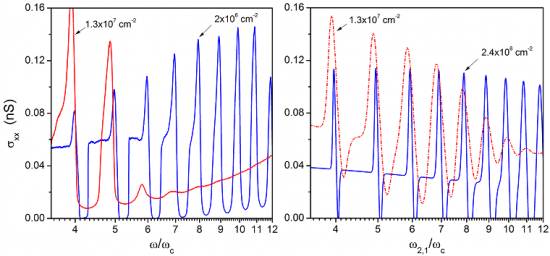
Figure 1: Comparison between experimentally observed dependence of MIMO on the electron density at T=200 mK (left panel) and theoretically calculated one (right panel). The observed agreement implies that the broadening and washing away of the oscillations can be accounted by effects of strong unscreened electron-electron interaction.
3.2 Zero-conductivity response under frequency-modulated (FM) microwave excitation (L. Abdurakhimov, A. Badrutdinov)
As demonstrated in the previous section, the theory gives reasonably good account for the experimentally observed MIMO. However, microscopic dynamics of the electron system in the regime of MIMO and zero-conductance states is still not completely clear. In particular, the theory assumes spatially uniform excitation of the electron system and ignores finite-size effects. We performed experiments showing that the effect of magneto-oscillations is local and involves only a part of the electron pool. The effect arises due to spatial variation of the electric field applied perpendicular to the 2D plane of the electron system, which causes spatial variation of the resonance frequency of electrons (see Fig. 2a). To overcome this spatial variation and tune the whole system into the resonance, we employed the frequency modulation (FM) of the microwave radiation. By using FM modulation, we can sweep the position of the resonant excitation area along the electron sheet. We found out that applying FM modulation broadens the zero-conductance region, as would be expected as more electrons are resonantly pumped by the microwave into the zero-conductance regime. Moreover, investigation of conductivity response on the modulation frequency reveals allowed us to obtain information about inter-subband relaxation rate. A report about this effect is under preparation.
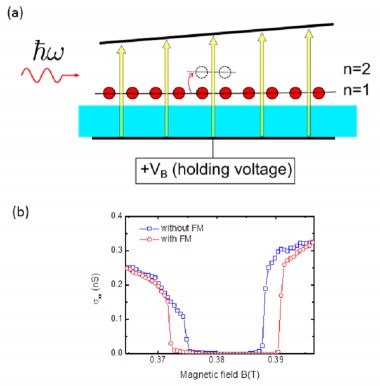
Figure 2. (a) Since top and bottom electrode plates of the experimental cell are slightly inclined, holding electric field is inhomogeneous along the electron pool. Therefore, due to Stark effect, intersubband resonance condition is fulfilled only for electrons from some narrow area of the electron pool. (b) Effect of FM modulation of the radiation source on the zero-conductance states.
3.3 Observation of an unexpected plasmon resonance in electrons on helium under strong CR excitation (Alex Badrutdinov, Leonid Abdurakhimov)
Dynamics of electrons on helium under a strong cyclotron resonance (CR) excitation was investigated last year (see FY2012 Annual Report, Sec. 3.3), and revealed a possible formation of a strongly overheated non-thermolized fraction of electrons (link). In a new experiment, we have found that such a system supports an unusual plasmon oscillation mode, which is absent in equilibrium. The observed mode consists of equidistant resonances (harmonics) of relatively low intensities, as compared to already known and readily observed edge magneto-plasmon (EMP) mode (see Fig. 3).
The mode frequency is nearly independent of the applied magnetic field, however, depends on the CR excitation power. This indicates that this resonance is fundamentally different from the EMP observed in this system, as well as in 2DEG in semiconductor-based devises. Apparently, there is a correlation between the new mode propagation and the CR-induced redistribution of charge found earlier. Yet the physics behind these unexpected modes unclear and requires further thorough experimental and theoretical investigations.

Figure 3: Current amplitude measured at an electrode, which is capacitively coupled to the electron system, versus plasmon excitation frequency. The measurements are done at T=200 mK and several values of CR excitation (20 GHz) powers. Traces are offset for clarity of representation. Arrows indicate the new plasmon mode.
3.4 Development of a cryogenic heterodyne millimeter-wave spectrometer for ESR experiments (William Powell, Leonid Abdurakhimov in collaboration with S. Vasiliev/Turku University/Finland)
One of the long term goals of our Unit’s research is the observation and study of the Electron Spin Resonance in 2D electrons floating above the surface of liquid helium. This would open an exciting playground for studying many-body phenomena in a spin system with extremely long spin-state coherence. It can also open prospects for spin-qubit implementation, quantum information storage, etc.
Observation of ESR in this system is a very challenging task due to long spin-state relaxation and rather small number of spins in the 2D system. Therefore, it is important to develop a very sensitive instrument to study spin dynamics in electrons on helium and, perhaps, other solid-based spin systems. For this purpose, we are building a cryogenic millimeter-wave heterodyne spectrometer with double frequency conversion (link). The heterodyne detection is chosen due to its inherently high sensitivity. Millimeter waves (~140 GHz) are used to excite spin-resonance in a nearly free-electron system placed in a magnetic field ~5 Tesla. Schematic diagram of the spectrometer is outlined in Fig. 4a. The most important and technically challenging part of the spectrometer is the first (cryogenic) frequency conversion stage which converts a ~1GHz IF signal into a millimeter-wave RF signal, feeds the latter into a Fabry-Perot resonator containing a spin sample, and down-converts the reflected signal back into ~1GHz signal. The second stage, which operates at the room temperature, uses a similar heterodyne scheme and converts ~1GHz signal into a ~100MHz signal detected using a commercial lock-in amplifier. In addition, a bridge circuit is employed at the second stage in order to eliminate the unwanted background. The detected ~100MHz signal contains complete amplitude and phase information about the signal reflected from the millimeter-wave resonator, thus giving complete information about the spin-resonance.
For the first conversion stage of the spectrometer, we employ a unique home-made design of the millimeter-wave mixers based on GaAs Schottky diodes. This mixers operate at temperatures down to 4 K exhibiting very low down-conversion losses <10 dB (see Fig. 4b), which is essential for sensitive detection of the millimeter-wave signal. However, the mixers show much larger up-conversion losses (see Fig. 4c), which at present limits the maximum power of the millimeter-wave signal fed to the resonator to about 1 micro-Watt. Further improvements in the mixer design and/or using a higher LO power should help us to overcome this limitation.
At present, we successfully completed and tested the first (cryogenic) stage of the spectrometer, see Fig. 5a. The measurements of the power reflected from a Fabry-Perot resonator located inside an experimental cell placed in the cryostat are shown in Fig. 5b. For these measurements, the IF signal was generated and detected using a network analyzer, which allowed to scan IF frequency within the bandwidth of the heterodyne stage. The resonance due to a home-made Fabry-Perot resonator (Q~10,000), which consists of two copper hemi-spherical mirrors, is clearly seen in Fig. 5b.
Currently, we use the spectrometer to investigate the inter-subband (electrical dipole) resonance in 2D electrons on helium. This would be the ultimate test for spectrometer performance before we move to the detection of ESR in this system.

Figure 4: (a) Diagram of the spectrometer, showing the components of the first (cryogenic) and second (room-temperature) frequency-conversion stages. (b) Down-conversion loss measurements of a mixer at T=4.2 K. (c) Up-conversion loss measurements of a mixer at T=300 K.
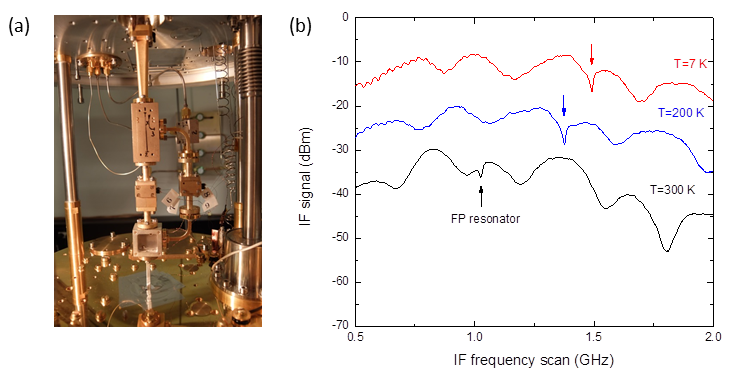
Figure 5: (a) Photo of the first conversion state of the heterodyne spectrometer operating at T=4 K. (b) Measurements of the power reflected from a Fabri-Perot (FP) resonator during cool down from room to liquid helium temperatures. The blue (T=200 K) and red (T=7 K) traces are up-shifted by +10 and +20 dBm, respectively, for clarity of representation. The measurements are done using the cryogenic stage of heterodyne spectrometer operating at 4 K with LO power +5 dBm at the frequency of 139.6 GHz. The up-shift of resonance frequency of the resonator with decreasing temperature is due to thermal contraction of copper.
3.5 Optomechanics with surface waves on superfluid helium (L. Abdurakhimov, W. Powell)
In recent years, much interest has been attracted to the new research field of physics – so called optomechanics – that studies the coupling between electromagnetic radiation (photons) and mechanical oscillations of macroscopic objects. Developments in optomechanics will help to investigate fundamental aspects of quantum mechanics and can be applied for construction of ultra-sensitive vibration sensors. In FY2013, for the first time, we experimentally observed the coupling between microwave radiation in a microwave resonator and surface oscillations of superfluid helium. Schematic diagram of the setup is shown in Fig. 6a. The liquid helium partially fills a high-Q Fabry-Perot cavity. When liquid helium surface is subjected to vibrations, the microwave power reflected from the resonator is also oscillating due to a change in the dielectric permittivity distribution inside the cavity. Strong variation is observed when microwave frequency is close to the resonance frequency of the cavity (Fig. 6b). As a test, we compared the power spectrum of such optomechanically detected surface oscillations with the spectrum of the vibration source, and found them in complete agreement, see Fig. 6c. These results show that the system of surface waves on liquid helium in a microwave cavity could be used as a novel test bed for optomechanics.
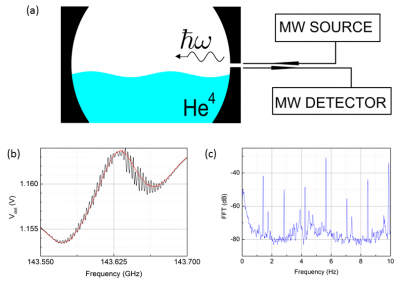
Figure 6. (a) Schematic diagram of the experimental setup to study coupling between surface waves on superfluid helium and microwave radiation in the cavity: microwave source feeds the Fabry-Perot cavity resonator partially filled with liquid helium, a cryogenic InSb detector measures power of reflected microwave radiation. (b) Microwave power reflected from the cavity at different frequencies of microwave radiation (black curve – cell is under vibrations, red curve – the vibration source is switched off). The resonant frequency of the Fabry-Perot cavity is about 143.625 GHz. (c) Power spectrum of optomechanically detected surface vibrations which coincides with the power spectrum of the vibration source, a PT cryocooler.
3.6 Development of a device for trapping single electrons on helium (Alex Badrutdinov, Jui-Yin Lin)
Progress has been achieved towards trapping and detection of single electrons on the surface of liquid helium. In particular, an experimental setup has been assembled and a prototype device has been fabricated and tested with electrons on helium below 1 K.
The device (see Fig. 7a) constitutes a set of lithographically defined channels, which are filled with superfluid helium-4. Electrons are deposited on the helium surface inside the channels. AC electric current of surface electrons through the central channel of the device is measured, while the electric potential across the central channel is tuned by varying gate voltages, applied to the set of electrodes at the bottom of the channel. Preliminary data indicates that the measured current can be switched on and off by applying appropriate gate voltages (similar to a semiconductor-based FET), which is the prerequisite for intended single electron trapping (Fig. 7b). However, we have also found that the initial design should be modified, to improve the device performance. Modifications have been introduced, and a new device has been fabricated and prepared for the experiment, to be performed in the coming year.
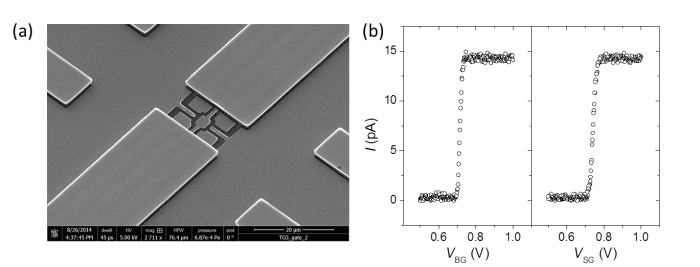
Figure 7: (a) An SEM image of a device, identical to the investigated one, focusing on the central channel configuration. (b) Representative I-V curves, showing electron current pinch-off as the gate voltages applied to the central back-gate electrode (left panel) and the split-gate electrodes (right panel) in the channel are swept more negative.
3.7 Investigation of non-linear NMR signals in MnCO3 and RbMnF3 antiferromagnets at temperatures below 1 K (Cameron Deans, Leonid Abdurakhimov, in collaboration with Yu. Bunkov/Institute Neel/France)
The Bose-Einstein Condensation of magnons, similar to an atomic BEC, was observed in 1984 in superfluid 3He-B. The same phenomenon was predicted to exist in solid antiferromagnets with strong hyperfine interaction owing to the similarities between dynamical properties of coupled nuclear-electron precession modes in these antiferromagnets and NMR of superfluid 3He-A. First confirmations of the proposed BEC scenario were obtained in CsMnF3 crystalline solid with easy-plane anisotropy at 1.5 K by studying the shift of NMR resonance with deflection of nuclear magnetization (link). Motivated by this work, our unit has started an experimental investigation of non-linear NMR in antiferromagnets MnCO3 with easy-plane anisotropy and RbMnF3 with cubic anisotropy at temperatures below 1 K.
It was predicted that the formation of BEC can be observed from certain features of the non-linear NMR signal at high excitation level. Therefore, it is important to measure a full complex NMR response of the magnetic system, that is both absorption and dispersion NMR signals in order to make correct interpretation of the observed results. For such measurements, we designed and assembled a 600 MHz Homodyne Spectrometer, a schematic diagram of which is shown in Fig. 8a. We used a split-ring type resonator containing two MnCO3 samples and one RbMnF3 sample. Linear NMR signals from the loaded cavity are shown in Fig. 8b. Either absorption (blue trace) or dispersion (red trace) signals can be recorded by mixing the power transmitted through the cavity and the large amplitude LO signal of varying phase (phase shifter 2) at the quadratic detector. In addition, a compensation arm (attenuator 1/phase shifter 1) allows to cancel out an unwanted background signal.
Non-linear NMR absorption signals taken at high excitation levels are shown in Fig. 8c. The frequency shift (pulling) of non-linear NMR signal is in accordance with the reported previously. However, we clearly observe independence of the absorption signal on the power level, in contradiction with previously reported independence of the signal amplitude (link). Our result makes it less obvious that the reported features of non-linear NMR in these antiferromagnets support the magnon BEC scenario. However, the complex dynamics of coupled nuclear-electron precession modes make theoretical analysis very difficult, and serious theoretical work must be done to interpret the observed result.
Our next step is to perform pulsed NMR studies in this system to look for a long free-induction decay signal arising from the magnon condensate, as was reported earlier (link).
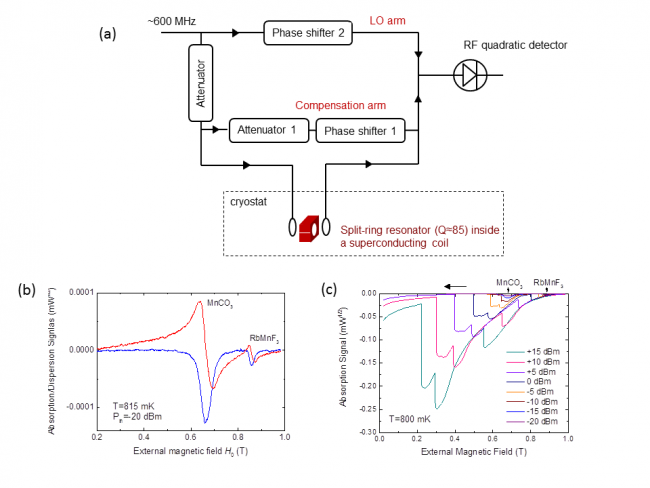
Figure 8: (a) Diagram of the homodyne spectrometer for non-liner NMR studies, (b) the absorption (blue trace) and dispersion (red trace) linear NMR signal at T=815 mK, (c) non-linear NMR absorption signal for different input RF power. The signals are from two MnCO3 samples and one RbMnF3 sample.
4. Publications
4.1 Journals
Konstantinov, D., Monarkha, Yu. P. & Kono, K. Effect of Coulomb Interaction on Microwave-Induced Magnetoconductivity Oscillations of Surface Electrons on Liquid Helium. Phys. Rev. Lett. 111, 266802, doi:DOI 10.1103/PhysRevLett.111.266802 (2013).
Badrutdinov, A. O. , Konstantinov, D., Watanabe, M. & Kono, K. Experimental Study of Energy Relaxation of Hot Electrons on Liquid Helium-4. Europhys. Lett. 104, 47007, doi:DOI 10.1209/0295-5075/104/47007 (2013).
Badrutdinov, A. O., Huang, S. M., Ono, K., Kono, K. & Tayurskii, D. A. Dynamic Nuclear Polarization with Three Electrons in a Vertical Double Quantum Dot. Phys. Rev. B 88, 035303, doi:DOI 10.1103/PhysRevB.88.035303 (2013).
Konstantinov, D., Watanabe, M. & Kono K. Self-Generated Audio-Frequency Oscillations in 2D Electrons with Nonequilibrium Carrier Distribution on Liquid Helium. J. Phys. Soc. Jpn. 82, 075002, doi:DOI 10.7566/JPSJ.82.075002 (2013).
Huang, S. M., Badrutdinov, A. O., Kono, K. & Ono K. A Possible Solution for Charge Sensing in Vertical Double Quantum Dots. J. Phys.: Condens. Matter 25, 345301 doi:DOI 10.1088/0953-8984/25/34/345301 (2013).
4.2 Books and Other One-Time Publications
Nothing to report.
4.3 Oral and Poster Presentations
Konstantinov, D. Magneto-transport phenomena in electrons on helium under inter-subband and cyclotron resonance, in International Workshop "MIRO and all that", Montpelier, France (May 2013).
Konstantinov, D. Microwave-induced zero-resistance states in a classical electron system on liquid helium, in University Paris-Sud, Orsay, France (May 2013).
Badrutdinov, A. O. Electrons on helium: towards quantum engineering, in International Workshop on Coherent Control of Complex Quantum Systems C3QS-2013, OIST, Japan (May 2013).
Konstantinov, D., Monarkha, Yu. P., & Kono, K. Effect of strong internal forces on microwave-induced magneto-oscillations in surface electrons on liquid helium, in International Symposium on Quantum Liquids and Solids QFS 2013, Matsue, Japan (August 2013).
Badrutdinov, A. O., Abdurakhimov, L. V. & Konstantinov, D. Cyclotron-resonance-induced dynamics of the electrons-on-helium system, in International Symposium on Quantum Liquids and Solids QFS 2013, Matsue, Japan (August 2013) .
Abdurakhimov, L. V., Badrutdinov, A. O. & Konstantinov, D. Redistribution of 2D Electrons on Liquid Helium under Pulse-Modulated MW Irradiation, in International Symposium on Quantum Liquids and Solids QFS 2013, Matsue, Japan (August 2013).
Abdurakhimov, L. V., Badrutdinov, A. O. & Konstantinov, D. The Role of Resonance Conditions at the Edge of 2D Electron Pool in MW-Induced Zero-Resistance States Formation in 2DES on Liquid Helium, in International Symposium on Quantum Liquids and Solids QFS 2013, Matsue, Japan (August 2013).
Konstantinov, D., Bunkov, Yu., Deans, C., Nerai, D., Badrutdinov, A. O. & Abdurakhimov, L. V. Magnon BEC in RbMnF3 and MnCO3 at a temperature about 1 K, in International Symposium on Quantum Liquids and Solids QFS 2013, Matsue, Japan (August 2013).
Abdurakhimov, L. V., Remizov, I. A., Levchenko, A. A. Excitation of Surface Waves by Second Sound Waves in Superuid Helium-4, in International Symposium on Quantum Liquids and Solids QFS 2013, Matsue, Japan (August 2013).
Abdurakhimov, L. V., Badrutdinov, A. O. & Konstantinov, D. “Magneto-Oscillations Induced by Frequency-Modulated MW-Irradiation in 2DES on Liquid Helium Surface, in International Symposium on Quantum Liquids and Solids QFS 2013, Matsue, Japan (August 2013).
Konstantinov D., Monarkha Yu. P. & Kono, K. Effect of Coulomb interaction on micorwave-induced conductivity oscillations in electrons on helium, in Annual Meeting of the Japanese Physical Society, Tokushima, Japan (September 2013).
Badrutdinov, A. O., Abdurakhimov, L. V. & Konstantinov Cyclotron-resonance-induced dynamics of the electron-on-helium system, in Annual Meeting of the Japanese Physical Society, Tokushima, Japan (September 2013).
Abdurakhimov, L. V., Badrutdinov, A. O. & Konstantinov, D Magneto-oscillations induced by frequency modulated MW irradiation in 2DES on liquid helium, in Annual Meeting of the Japanese Physical Society, Tokushima, Japan (September 2013).
Konstantinov, D. Electrons on helium: towards quantum engineering, in International Quantum Science Symposium QSS-ASIA 2013, University of Tokyo, Japan (November 2013).
5. Intellectual Property Rights and Other Specific Achievements
Nothing to report
6. Meetings and Events
6.1 Research Visits
- Prof. Yu. Bunkov, Institute Neel, CNRS, Geranoble, France
- Prof. S. Vasiliev, Turku University, Finland
- Prof. A. Ghosh, Indian Institute of Science, Bangalore, India
6.2 Seminars
- Date: June 26, 2013
- Venue: OIST
- Speaker: Prof. Yu. Bunkov, Institute Neel, CNRS, Geranoble, France
- Title: Observation of Majorana fermions in superfluid 3He
- Date: Jule 25, 2013
- Venue: OIST
- Speaker: Prof. Yu. Bunkov, Institute Neel, CNRS, Geranoble, France
- Title: BEC of magnons in magnetic crystals
- Date: November 14, 2013
- Venue: OIST
- Speaker: Prof. S. Vasiliev, Turku University, Finland
- Title: Electron spin waves in high density quantum gas of atomic hydrogen
- Date: November 15, 2013
- Venue: OIST
- Speaker: Prof. S. Vasiliev, Turku University, Finland
- Title: Microscopic control of dynamic nuclear polarization in P doped silicon in strong magnetic fields
- Date: November 19, 2013
- Venue: OIST
- Speaker: Prof. A. Ghosh, Indian Institute of Science, Bangalore, India
- Title: Trapping and manipulating multielectron bubbles in liquid helium
- Date: November 20, 2013
- Venue: OIST
- Speaker: Prof. A. Ghosh, Indian Institute of Science, Bangalore, India
- Title: Optical and hydrodynamical effects in chiral nanostructures and their interplay
7. The Category or Type of Funding, like External Funding, Awards, etc.
Grant-in-Aids for Scientific Research (KAKENHI MEXT), Scientific Research (C), “Spin superfluidity in solid antiferromagnets” (反強磁性体におけるスピン超流動の核磁気共鳴研究).



